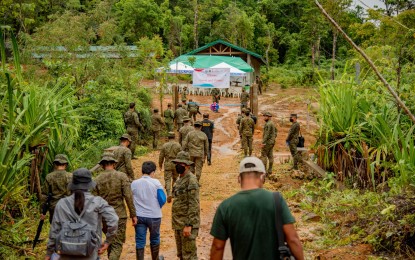
REINTEGRATION. The entrance to the training center for former New People’s Army rebels in Fatima village in Hinabangan, Samar during the inauguration on May 31, 2022. Samar province is eyeing to reverse its reputation from conflict-stricken to a peaceful and developed area with the completion of a peace house and the training facility meant for surrendered rebels. (Photo courtesy of the Department of the Interior and Local Government)
TACLOBAN CITY – Samar province is eyeing to reverse its reputation from conflict-stricken to a peaceful and developed area with the completion of a peace house and a training facility for former members of the New People’s Army (NPA).
The two major projects complement the Local Social Integration Program (LSIP) to encourage more rebels to yield to the government and be productive, Samar provincial social welfare and development officer Alma Austero said Thursday.
“For decades, Samar has been known as a province affected by armed struggle. Through this approach, we want to change others’ perception about Samar,” Austero said in a phone interview.
Austero said officials from the national and local governments inaugurated on May 31 the PHP4.5-million peace house conceptualized in 2017. The facility is inside the Philippine Army’s 8th Infantry Division compound in Catbalogan City, Samar.
It will serve as a one-stop shop for the processing of Enhanced Comprehensive Local Integration Program (E-CLIP) and LSIP beneficiaries.
“A former rebel will stay in the peace house for one to three months provided with appropriate social-economic interventions, quality programs and services to help them restore their psycho-social functioning,” Austero said.
Imelda Bonifacio, manager for Eastern Visayas of the Office of the Presidential Adviser on Peace, Reconciliation and Unity, said their office funded the project to cater the increasing number of surrenderers.
The peace house has four rooms that can each accommodate six to eight occupants. Qualified to stay are either regular members or staunch allies of the communist terrorist group in Samar who have yielded to authorities.
“Their stay in the peace house is necessary to expedite their reintegration process in mainstream society. The journey of peace is not an easy task, we may experience all the hardships and challenges but now is not the time to stop. We are now succeeding and reaping the gains of peace,” Bonifacio said.
After their stay at the peace house, they will be transferred to a training center in Fatima village in Hinabangan, Samar, also inaugurated on May 31.
At the training center, the Office of the Provincial Agriculture, Department of Trade and Industry, Department of Labor and Employment, Technical Education and Skills Development Authority, and other agencies will be capacitating former rebels.
“They will be provided with skills enhancement training and kits in an effort to hasten the reintegration process. The provincial government will shoulder all their expenses while undergoing skills and livelihood training,” Austero added.
After the training, former rebels will have the option to return to their village or move to the government’s socialized housing project in Pinabacdao, Samar.
These projects, Austero said, have been the priority of Governor Reynolds Michael Tan as part of the whole-of-nation approach to end the local communist armed conflict in the province.
Samar Island is considered as one of the strongholds of armed rebels due to the densely forested mountainous areas, high poverty incidence, and issue of widespread landlessness, based on a 2013 study of William Norman Holden of the University of Calgary in Canada.
The NPA launched its first tactical operation in the country in Calbiga, Samar in 1974, when its members ambushed an Army scout patrol and seized several weapons.
In 1976, the NPA gained popular support among the inhabitants of Samar following its actions against cattle rustling gangs.
The NPA, which has been engaged in a five-decade armed struggle, is listed as a terrorist organization by the United States, the European Union, the United Kingdom, Australia, Canada, New Zealand, and the Philippines.
The National Democratic Front has been formally designated as a terrorist organization by the ATC on June 23, 2021, citing it as “an integral and inseparable part” of the CPP-NPA created in April 1973. (PNA)
